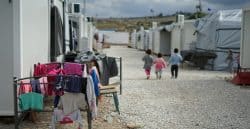Would you like us to share more content related to indigenous communities around the world? Let us know in the comments!
Indigenous peoples in Canada and the United States continue to be disproportionately represented in recorded numbers of trafficking survivors. The long-term impacts of colonization processes, displacement, racism, discrimination and barriers to education that have led to higher instances of poverty and homelessness are some of the contributing factors to increased instances of abuse and violence facing indigenous communities.
At the intersection of these vulnerabilities, the risk of trafficking increases. A 2018 report by the Native Women’s Association of Canada found that indigenous women are overrepresented in national trafficking cases in Canada making up a staggering 50% of identified trafficking victims, but only 4% of the population.
This overrepresentation of indigenous women and girls in trafficking statistics, within North America and elsewhere, is situated within a historical context of systemic violence, family separation and land dispossession at the hands of the state. Trafficking does not occur in a vacuum. In fact, the systemic exploitation that laid the foundation for the conditions that allow this crime to thrive today can be traced back hundreds of years.
In the context of the U.S., a 2019 investigation from Searchlight New Mexico uncovered the extent to which indigenous women and girls in the state of New Mexico are overlooked by authorities as trafficking survivors in need of support – they are “the least recognized and least protected population.”
This article was originally published by the Guardian in 2019.
Eva was found at dusk in late December 2016, standing in an Albuquerque parking lot. The 15-year-old Navajo girl had been missing more than two weeks when her grandmother got a call from the Bernalillo county sheriff’s office – saying her silver Ford truck had been recovered.
“I don’t care about the truck, what about my granddaughter?” Heidi demanded.
She drove three hours, from her house outside Gallup, and arrived a few minutes after 1am to see Eva emerge from the juvenile holding area, quiet and hunched. Her cheeks and neck looked skeletal. She kept her answers short and rolled her eyes. A familiar pattern was unfolding.
Back in the car, Heidi locked the doors. Give me my phone, Eva said.
Eva was among the thousands of human trafficking victims targeted and exploited in the US every year, of whom only 10% are ever identified. In New Mexico, a mere 160 cases have been opened since 2016.
But, while Native Americans make up about 11% of the state’s population, they account for nearly a quarter of trafficking victims, according to data compiled from service organizations.
A 16-month investigation by Searchlight New Mexico has found that when it comes to human trafficking, indigenous women and girls are the least recognized and least protected population in a state that struggles to address the problem.
An almost total lack of protocols, mandated training and coordination among law enforcement systems and medical institutions has ensnared victims in ongoing cycles of exploitation.
That includes Eva, who, by her own recounting as well as notes from medical personnel, caseworkers and therapists, was systematically lured, coerced, threatened and traded for sex for money, drugs and favors over a two-year period. Her name, along with those of her family members, have been changed for reasons of safety and privacy.
Eva showed many of the warning signs of someone who has been trafficked. She was anxious, depressed, mute and had little sense of time. She was frequently reported missing, appeared malnourished and occasionally bruised. But despite multiple brushes with law enforcement agencies and healthcare institutions, she was not once questioned or screened for human trafficking.
“Nobody saw me,” she says. “Not until the very end.”
Growing up on the Zuni and Navajo reservations of western New Mexico, Eva moved continuously between her mother’s home and that of her grandparents, aunts, uncles and cousins. The only constant in her life was Haley, her sister four and a half years her junior.
Eva was the effusive one, admired for her lanky limbs and her gift for sketching. She was the one to initiate games of basketball in the driveway, scolding her cousins when they didn’t pass the ball to Haley.
The girls’ mother, Lea, worked multiple jobs as a nurse’s aide, and the family had a comfortable life in an area where the median household income hovers at $27,000 a year.
Lea entered the girls in child beauty pageants in the big cities of Gallup, Albuquerque and Las Cruces. She was the kind of mother who on a whim would take them on a road trip to White Sands Monument or the redwood forests of northern California.
That all changed the year Eva turned 11. Lea had long struggled with alcoholism, and as the disease worsened she increasingly left her daughters in the care of others or alone at home.
When she was too intoxicated to drive, she propped Eva on a pile of blankets to see over the steering wheel of the family’s 1999 Honda Civic. Eva began skipping school, where she got in trouble for smoking. In seventh grade, she was expelled for fighting and never went back.
Only later would Eva and Haley confide in their grandmother that their stepfather physically, sexually and emotionally abused them. “Don’t you tell Grandma what happens in this house,” he often said.
Heidi said she kept as close a watch as she could, and when she saw them, she would give the girls almost anything they wanted. For Eva’s 12th birthday, her grandmother bought her an iPhone, so Eva could call whenever they were left alone at home.
“Buying her that phone was the worst thing I ever did,” Heidi says now.
On 8 December 2015, Eva saw a Facebook message from a young man with a thick brow and a round jawline. “I remember you from middle school,” he wrote.
Eva, then 13, didn’t recognize him, but she assumed she knew him. “Everyone on the reservation knows everyone,” she says. “Or they pretend they do.”
D, as she came to call him, enthused about her large brown eyes, her dimples and the way she wore her hair in French braids. He asked for photos and she sent him intimate selfies, soon followed by more explicit pictures.
She eventually drove to his house in her mother’s car – propped up on blankets – and they drank beer and smoked marijuana. D told her he loved her, and Eva felt needed and exultant, unmoored from the problems at home.
As the months went by, he took more photos and recorded videos – usually of Eva performing oral sex. His affectionate ways were soon supplanted by forceful sex, violence and threats.
He threatened to share his photos and videos on Facebook and hurt her little sister if she were to say anything. He invited other men – he said they were his brother and cousin – to the house, where they also molested and raped Eva.
She remembers initially resisting, punching one of them, and hearing the words “Just do it” before a weight fell on her.
In the fall of 2016, D redoubled his threats against Eva, promising to harm her grandmother and abduct her sister if she spoke out. If anyone could have helped Eva, it would have been her mother.
Lea knew, or at least suspected, what was happening; she had seen the nude photos of her daughter and did nothing. Then in November, she died after an incident near Shiprock.
For weeks after the funeral Eva lay on the floor of her grandmother’s house, while her phones buzzed with messages. By now, she had four Samsung cellphones, all supplied by D, who texted daily, demanding more photos, threatening violence unless she picked herself off the ground and met him.
Which she did, as if pulled by a wire tethered to her feet – driving or being driven to faraway towns and switching between cars with strange men.
Sex trafficking is defined as the exploitation of individuals through threat or use of force, coercion and/or fraud to induce a “commercial sex act”. It is a growing crime that’s estimated to generate $99bn a year globally, and in the US, people of color – mostly black and indigenous women – are victimized at the highest rates.
But the mainstream definition need to be reshaped when considering the ways indigenous women and girls are victimized, says Maureen Lomahaptewa, a Hopi woman and caseworker at the Life Link, a Santa Fe-based not-for-profit that shelters and serves trafficking victims.
This year, the Navajo nation council delegate Amber Kanazbah Crotty spearheaded an as yet unpublished white paper on trafficking in the Navajo nation. It is intended to serve as a warning to policymakers – though not all tribal leaders regard the issue with the same urgency. The Navajo nation police chief, Philip Francisco, for one, says he does not see sex trafficking as a problem in his jurisdiction. “It’s more of a border issue,” he says.
Of course, trafficking and exploitation are hardly a new phenomenon in indigenous communities. For centuries, sexual violence has been a cornerstone of the treatment of Native American populations, integral to colonization and displacement. Sex trafficking of contemporary indigenous women is “almost indistinguishable from the colonial tactics of enslavement, exploitation, exportation and relocation”, writes Sarah Deer, professor of law at Kansas University and author of The Beginning and End of Rape: Confronting Sexual Violence in Native America.
Today, high rates of chemical dependency, abuse and involvement in the foster care system exacerbate vulnerability to predators, the vast majority of whom are non-Native. As noted in Crotty’s white paper, female minors, homeless youth and transgender or two-spirit/LGBTQ+ people are most vulnerable to trafficking. And, as tribal leaders have found in NDFS cases, family members have been known to exchange younger children for money, drugs or basic needs. “We’ve seen our children trafficked by their own family, and most don’t even know they were trafficked,” says Crotty.
After conducting more than 75 interviews and gathering data from 18 agencies, Searchlight shared Eva’s story with nine tribal police officers, four tribal officials and two former clinicians for the Indian Health Service. No one expressed surprise.
“Tribal agencies are understaffed, underfunded and undertrained in this type of response,” says Darren Soland, Ramah Navajo police chief. “Once someone who is being victimized goes from tribal to state land or to a municipality and maybe comes back, it’s hard to get the agencies to reach out and communicate with each.”
A July 2019 study in the journal Criminology & Public Policy explored the reasons why law enforcement officers rarely recognize trafficking victims and found that some say they are unaware that this is a crime over which they have jurisdiction while others don’t believe it is an issue present in their communities. The majority of states, including New Mexico, require no law enforcement training on human trafficking.
And while lawmakers have proposed legislation, their efforts have largely stalled. The renewal of the Violence Against Women Act, which would better assist indigenous victims and increase cross-agency communication, is stalled in the US. Senate.
In a written response to questions, a spokesperson from the FBI’s New Mexico headquarters wrote: “The FBI is committed to fulfilling our mandate to investigate the most serious crimes in Indian Country … The FBI aggressively investigates any reports of human trafficking, using force-multiplying Human Trafficking Task Forces.”
The latest national figures, however, show that federal prosecutors declined nearly half of all cases in Indian Country in 2017. The District of New Mexico US attorney’s office, the third busiest district in the country for Indian Country cases, has declined 69% of cases that fall under the “offenses committed within Indian Country” statute and 80% of cases falling under child abuse in Indian Country, according to data from the Trac research center at Syracuse University.
“We’re letting the FBI off the hook way too easily,” said Mary Kathryn Nagle, a Cherokee Nation lawyer and counsel to the National Indigenous Women’s Resource Center. “And I wish more senators would call them to account for how few investigations go anywhere. They need to have an oversight hearing on why the FBI is abdicating its duties.”
In December 2016, Eva was handcuffed outside a Dollar Store in north-east Albuquerque for stealing her grandmother’s truck, and placed in a 90-day program at Butterfly Healing Center, a co-ed treatment center for Native American teens in Taos. That’s where, at last, she began to talk.
Her disclosure set in motion a string of reports that reverberated across agencies and culminated in a three-hour interview with the FBI. To date, no charges have been filed.
In the last 14 months since departing a safe house, Eva, now 18, and Haley, 13, have each enrolled in two new schools and changed apartments three times. Eva has gone missing once. She has also been arrested once.
Many nights, she resists sleep. Nightmares ensue, and the sensation of near-sleep reminds her of the feeling she experienced when she was being trafficked – weightless and contorted underwater.
“I want to make it not real. But I was living there. And sometimes, I’m still living there.”








Freedom United is interested in hearing from our community and welcomes relevant, informed comments, advice, and insights that advance the conversation around our campaigns and advocacy. We value inclusivity and respect within our community. To be approved, your comments should be civil.
Native Americans have been exploited every way that a people can be exploited for more than 500 years. We will never be able to adequately compensate them for the suffering and injustice that they have experienced, but we can certainly devote additional resources both to assist Native survivors and to prosecute the people who traffick them. I applaud Freedom United for helping to shed a light on this urgent problem. I encourage staff to continue writing about this very important issue.
I would like you to share more content related to indigenous communities around the world. Eva’s story shows how easy it is to be drawn into sex trafficking through social media, especially Facebook.